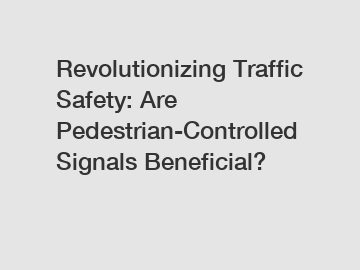Revolutionizing Traffic Safety: Are Pedestrian-Controlled Signals Beneficial?
Revolutionizing Traffic Safety: Are Pedestrian-Controlled Signals Beneficial?
In today's fast-paced and congested world, traffic safety is a critical concern for both pedestrians and motorists. Many cities have introduced pedestrian-controlled signals as a means to improve safety and ensure a smooth flow of traffic. However, the effectiveness and benefits of such signals have been the subject of debate. Are pedestrian-controlled signals truly beneficial, or are they causing more harm than good? Let's delve into this question and explore the various points surrounding this topic.
1. Empowering Pedestrians:

One of the key advantages of pedestrian-controlled signals is their ability to empower pedestrians. These signals provide pedestrians with a sense of control over their own safety, allowing them to determine when it is safe to cross the road. This can result in increased confidence and a greater sense of security among pedestrians, leading to a positive change in behavior and adherence to traffic rules.
2. Enhancing Safety:
Pedestrian-controlled signals are designed to enhance safety by regulating the flow of traffic at intersections. By providing a dedicated signal phase for pedestrians, these signals reduce conflicts between vehicles and pedestrians. When pedestrians have their own signal, motorists are more likely to yield and give them the right of way, minimizing the risk of accidents and injuries. This can be especially beneficial in high-traffic areas and during peak hours.
3. Efficient Traffic Flow:
Contrary to popular belief, pedestrian-controlled signals can actually improve the overall flow of traffic. By allocating specific time intervals for pedestrian crossings, these signals ensure that pedestrians do not disrupt the smooth movement of vehicles. This can help reduce congestion, increase the capacity of road networks, and minimize delays for both pedestrians and motorists. Efficient traffic flow translates to improved fuel efficiency and reduced emissions, contributing to a greener environment.
4. Considerations for Vulnerable Populations:
While pedestrian-controlled signals offer numerous benefits, it is important to consider the needs of vulnerable populations. Elderly individuals, people with disabilities, and children may face challenges in operating these signals effectively. To ensure inclusivity and accessibility, it is crucial to design pedestrian-controlled signals that can be easily understood and operated by everyone. Adequate infrastructure and clear instructions, such as auditory cues or tactile buttons, should be put in place to accommodate the diverse needs of pedestrians.
5. Education and Awareness:
While pedestrian-controlled signals can significantly contribute to traffic safety, proper education and awareness campaigns are essential to fully harness their benefits. Pedestrians need to be educated on how to effectively use these signals, including understanding the meaning of different signal indications and following traffic rules. Motorists also need to be informed about their obligations when encountering pedestrian-controlled signals, enabling them to yield and respect the right of way. Comprehensive educational initiatives can bridge the gap in knowledge and ensure responsible behavior from all road users.
In conclusion, pedestrian-controlled signals have the potential to revolutionize traffic safety by empowering pedestrians, enhancing safety, improving traffic flow, and considering the needs of vulnerable populations. However, the successful implementation of these signals relies on well-designed infrastructure, education, and awareness campaigns. By fostering a harmonious relationship between pedestrians and motorists, pedestrian-controlled signals can contribute to creating safer and more efficient road environments. As cities continue to strive for innovation in traffic safety, the question remains: Are pedestrian-controlled signals truly beneficial? The evidence suggests that when implemented thoughtfully and alongside comprehensive education programs, these signals can play a pivotal role in reducing accidents and improving the overall traffic experience for everyone. So, let's embrace this revolution in traffic safety and make our roads safer for pedestrians and motorists alike.
If you are looking for more details, kindly visit variable message display, highway traffic electro-mechanical system Supplier, solar-powered traffic signs and displays.


